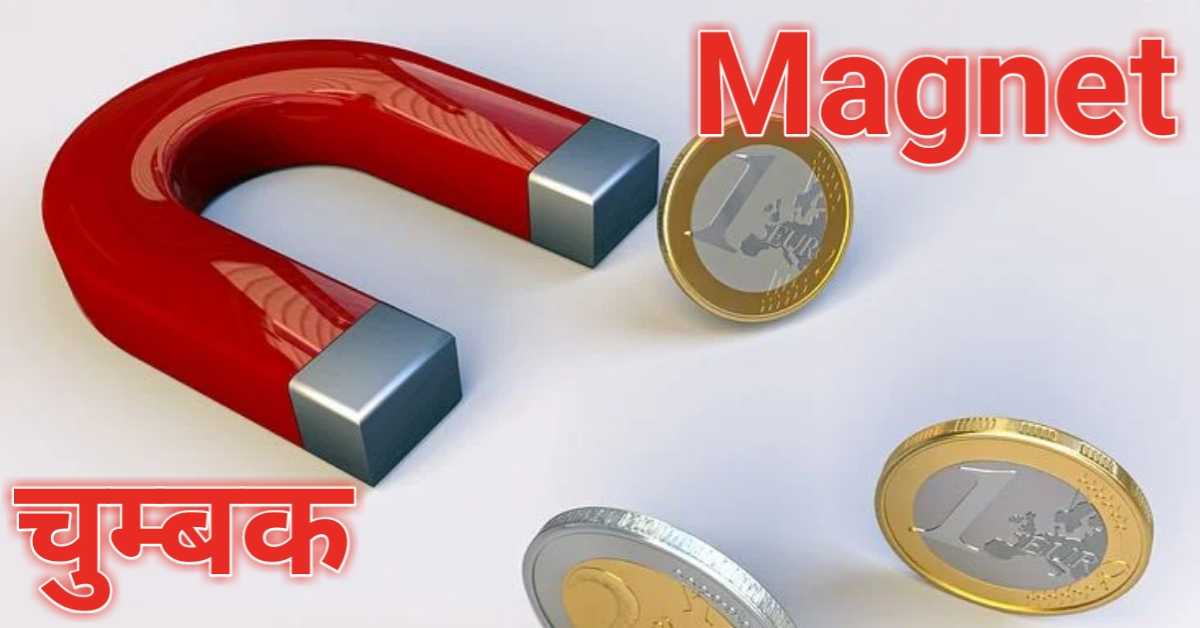
चुम्बक क्या है? | चुम्बक के गुण || What Is A Magnet? | Properties Of Magnets
चुम्बक और चुम्बकत्व (Magnet and Magnetism)
वह पदार्थ जो चुम्बकीय वस्तुओं (लोहा, कोबाल्ट तथा निकिल) को आकर्षित करता है, 'चुम्बक' कहलाता है। चुम्बक द्वारा चुम्बकीय वस्तुओं को आकर्षित करने के गुण को 'चुम्बकत्व' कहते हैं।
The material which attracts magnetic objects (iron, cobalt and nickel) is called 'magnet'. The property of attracting magnetic objects by a magnet is called 'magnetism'.
सामान्य ज्ञान के इन 👇 प्रकरणों को भी पढ़ें। (Also read these 👇 episodes of General Knowledge.)
बाढ़ आपदा क्या है? | कारण एवं रोकथाम || What Is A Flood Disaster? | Causes And Prevention
चुम्बक के प्रकार (Type Of Magnet)
चुम्बक प्रमुख रूप से दो प्रकार के होते हैं–
1. अस्थायी चुम्बक– वह चुम्बक जिसका चुम्बकत्व शीघ्र नष्ट हो जाता है, अस्थायी चुम्बक कहलाता है।
2. स्थायी चुम्बक– वह चुम्बक जिसका चुम्बकत्व शीघ्र नष्ट नहीं होता है, स्थायी चुम्बक कहलाता है। स्थायी चुम्बक लोहा, निकिल और कोबाल्ट से बनाए जाते हैं।
There are mainly two types of magnets–
1. Temporary Magnet– The magnet whose magnetism quickly dissipates is called a temporary magnet.
2. Permanent Magnet– The magnet whose magnetism does not get destroyed quickly is called permanent magnet. Permanent magnets are made from iron, nickel and cobalt.
सामान्य ज्ञान के इन 👇 प्रकरणों को भी पढ़ें। (Also read these 👇 episodes of General Knowledge.)
क्रिस्टलीय ठोस और अक्रिस्टलीय ठोस क्या होते हैं? | What Are Crystalline Solids And Amorphous Solids?
चुम्बक के गुण (Properties Of Magnets)
चुम्बक के प्रमुख गुण निम्नलिखित हैं–
1. यह चुम्बकीय पदार्थों को आकर्षित करता है। चुम्बक की आकर्षण शक्ति ध्रुवों पर अधिक तथा बीच में कम होती है।
2. स्वतंत्रता पूर्वक लटका हुआ चुम्बक हमेशा उत्तर-दक्षिण दिशा में ठहरता है। वह सिरा जो हमेशा उत्तर की ओर ठहरता है, 'उत्तरी ध्रुव' कहलाता है। वह सिरा जो हमेशा दक्षिण की ओर ठहरता है, 'दक्षिणी ध्रुव' कहलाता है। दोनों ध्रुवों के बीच की दूरी को 'प्रभावकारी लम्बाई' कहते हैं।
3. चुम्बक के सजातीय ध्रुवों में प्रतिकर्षण तथा विजातीय ध्रुवों में आकर्षण होता है।
4. चुम्बक, चुम्बकीय पदार्थों में प्रेरण द्वारा चुम्बकत्व उत्पन्न कर देता है। चुम्बक की उपस्थिति में किसी चुम्बकीय पदार्थ में अस्थायी चुम्बकत्व उत्पन्न होने की घटना को 'चुम्बकीय प्रेरण' कहते हैं।
5. एक अकेले चुम्बकीय ध्रुव का कोई अस्तित्व नहीं होता। चुम्बक के कितने ही टुकड़े कर दिए जाएँ वह पुनः पूर्ण चुम्बक बन जाता है।
6. चुम्बक को पीटने, गर्म करने, पटकने या घिसने पर चुम्बकत्व नष्ट हो जाता है।
The following are the main properties of a magnet–
1. It attracts magnetic materials. The force of attraction of a magnet is greater at the poles and lesser in the middle.
2. A freely hanging magnet always stays in the north-south direction. The point which always points towards the north is called the 'North Pole'. The point which always points towards the south is called the 'South Pole'. The distance between the two poles is called the 'effective length'.
3. There is repulsion at the like poles of a magnet and attraction at the opposite poles.
4. Magnet produces magnetism by induction in magnetic materials. The phenomenon of producing temporary magnetism in a magnetic material in the presence of a magnet is called 'magnetic induction'.
5. A single magnetic pole does not exist. No matter how many pieces a magnet is cut, it becomes a complete magnet again.
6. Magnetism is destroyed when a magnet is struck, heated, tossed or rubbed.
भौतिक विज्ञान के इन 👇 प्रकरणों को भी पढ़ें। (Also read these 👇 episodes of Physics.)
1. अच्छे ईंधन का चयन कैसे करें? | How To Choose Good Fuel?
2. नाभिकीय ऊर्जा क्या है? | What Is Nuclear Energy?
3. नाभिकीय संलयन क्या है? | हाइड्रोजन बम || What Is Nuclear Fusion? | Hydrogen Bomb
4. नाभिकीय विखण्डन क्या है? | What Is Nuclear Fission?
5. नियंत्रित और अनियंत्रित श्रृंखला अभिक्रिया | Controlled And Uncontrolled Chain Reaction
"भारतीय कला एवं संस्कृति" के इन 👇 प्रकरणों को भी पढ़ें। (Also read these 👇 episodes of "Indian Art and Culture".)
1. भित्ति चित्रकला एवं लघु चित्रकला | Mural Painting & Miniature Painting
2. अजंता गुफाओं की चित्रकला (एवं जातक कथाएँ) | Painting Of Ajanta Caves (And Jataka Tales)
3. चित्रकला– ऐलोरा, बाघ, अर्मामलई, चित्तानवासल | Painting– Ellora, Bagh, Armamalai, Chittanvasal
4. चित्रकला– रावण छाया, लेपाक्षी, जोगीमाथा, बादामी | Indian Paintings
5. प्रारंभिक लघुचित्र– पाल शैली एवं अपभ्रंश शैली | Pala Style And Apabhramsa Style
आशा है, उपरोक्त जानकारी उपयोगी एवं महत्वपूर्ण होगी।
(I hope the above information will be useful and important. )
Thank you.
R. F. Tembhre
(Teacher)
pragyaab.com




Comments